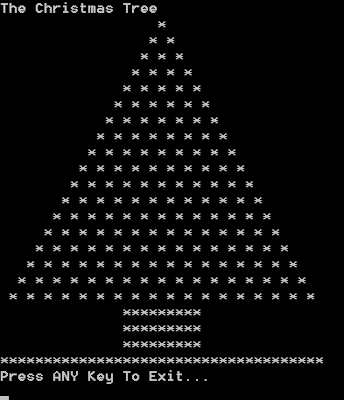-
ASCII ART IN C++ "CHRISTMAS TREE" (USING THE "FOR" LOOP)
This program’s focus is on ASCII Art, a very famous and effective way to produce meaningful pictures and logos out of Alphabet characters and punctuation marks. The main programming element in this simple implementation is the “For” loop.

Download "ASCIIArtWithFor"
-
PICTURING LETTERS DISTRIBUTION IN A TEXT USING A “HISTOGRAM”
This is a C++ Program to read a text from an external file, whose name will be given on the Command-line. The program calculates the incidence of every letter in the Latin alphabet in the text. The program does not differentiate between Upper-case and Lower-case letters in the text (not perceived as two different characters). Spaces, numbers, etc. are ignored. The program will produce as an output a Histogram picturing how many times a letter occurs in the input text. The Histogram consists of a Vertical Axis to limit the maximum number of occurrences of a character and a Horizontal Axis, as in the following example:

This program’s output is displayed on the screen in Character Mode.
Usage Example: If the input given sequence is, "Hello! This is my first assignment for the first Year of studies in the BSc Computing (Games Development) Course", contained in the “text.txt” file, we can use the following command to run the program: c:\> CppCharCount text.txt

Download "CharCount"
-
TEXT ENCRYPTION
A simple “Text Encryption” method can be implemented in accordance to the following simple rules:
a) We match the letters of the alphabet (Latin) with the numbers 0 to 25.
b) We assume the existence of a Text K and a Key-word of N letters.
c) We take the first character of the Text K we want to “Encrypt” and we create another character specified by the ASCII Numbers Sum of this character and the first Key-word character.
d) If the sum is out of range in respect to the total number of characters in the alphabet we proceed by subtracting 26 from that number.
e) We continue the process with the second character of the Text K we want to “Encrypt” and correspondingly the second character of the Key-word.
f) We continue to the last character in Text K.
g) Each time we run out of Key-word letters we initialise and take the first letter of the Key-word again (i.e. we use the letters in the Key-word in recycling manner).
A C++ program to implement “Encryption” and “Decryption” of any given text provided as a “.txt” file needs to be able to accept three parameters:
1. Parameter “-enc” or “-dec”: This parameter will determine the action to be performed (“Encryption” or “Decryption”).
2. “-cipher” : Determines the key word (up to 10 characters, for the Algorithm we develop here).
3. : the filename which contains our text to be “Encrypted”.
Example:text.txt (content): Attack at dawn.
Command: CppCryptography –enc –cipher lemon test.txt
Program Output: lxfopv mh oeib
Test.enc (content): lxfopv mh oeib.
Command: CppCryptography –dec –cipher lemon test.enc
Program Output: Attack at dawn.
.png)
.png)
Download "Cryptography"
-
COMPACT CASSETTE LABEL CREATOR
The Compact Cassette, also commonly called Cassette Tape, Audio Cassette, or simply Tape or Cassette, was a magnetic tape recording format for audio recording and playback released by PHILIPS in 1962. Compact Cassettes were known to exist in two forms, either already containing content as a Pre-recorded Cassette, or as a Fully Recordable “Blank” Cassette. Compact Cassettes were the only medium to record and exchange music during the ‘60s, 70s and ’80. This program was written to provide users with the ability to create Contents Labels for the Compact Cassettes (could be attached to the Compact Cassette's plastic case) in much the same way todays CD/DVD Label Printing software does.
.png)
.png)
.png)
Download "Kassetes"
-
LIST MEMORY USAGE
The program demonstrates how List Memory can be manipulated through C++.

Download "ListMemoryUsage"
-
PHYSICS CALCULATIONS
The program provides a very simple example on how Physics Programming can be achieved within C++.

Download "PhysicsCalculations"
-
SCREEN SAVER
This program is a Screen Saver implementation in C++ of the old “Stars” Screen Saver.
.png)
.png)
Download "ScreenSaver"
-
THE "SNAKE" GAME
The “Snake” game was first developed in QuickBasic and distributed free of charge (as one of three example programs) along a QuickBasic version included in MS-Windows 95. Became enormously famous in its early ‘2000 version for Mobile Phones (all Mobile Phones had low resolution Black & White screens back in these days) and ever since is considered one of the Mobile Platform’s games programming pioneers and classics.

Download "Snake"
-
STACK MEMORY USAGE
The program demonstrates how Stack Memory can be manipulated through C++.

Download "StackMemoryUsage"
-
"STOCK CONTROL" PROGRAM
This is a simple implementation of a “Stock Control” program of the kind was very popular twenty years ago.
.png)
.png)
Download "StockControl"